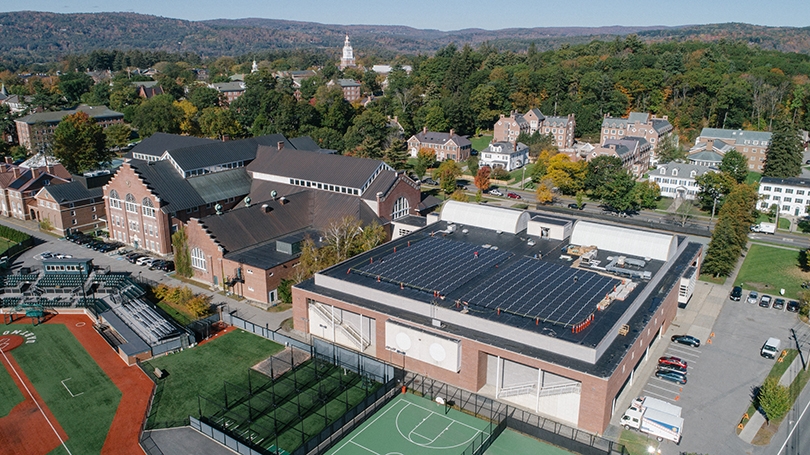
- About
- Departments
- Construction on Campus
- Service Requests
Back to Top Nav
Back to Top Nav
Berry Sports Center is one of three campus buildings with new rooftop arrays.
In a few weeks, over 400 photovoltaic panels atop Berry Sports Center will start harnessing energy from the sun. Berry is one of three campus buildings with new solar systems installed by ReVision Energy, a company based in Northern New England. Davis Varsity House and the MacLean Engineering Sciences Center also have solar arrays under the same contract with ReVision.
Under a warm sun on Berry’s flat, black roof, Dan Weeks, ReVision’s director of market development for New Hampshire and Massachusetts, and James Hasselbeck, its operations manager, explained that ReVision and Dartmouth have entered a mutually beneficial “purchased power agreement,” known as a PPA.
“These three systems are installed at no cost to Dartmouth College right now, and the College is purchasing the electricity generated by the solar panels from ReVision at a discounted rate. In six to seven years the College can buy the panels outright at a significantly discounted cost,” said Hasselbeck.
PPAs are motiving many nonprofit institutions to go solar, Weeks said. To encourage the transition to solar energy, the federal government provides tax credits, and many states, including New Hampshire, offer tax rebates. Dartmouth does not carry a tax liability, so it cannot benefit directly from those financial incentives. On the other hand, ReVision can qualify for those subsidies, allowing it to pass along savings to customers in the form of discounted kilowatts.
“Dartmouth is going to save six figures over the life of the array, and we expect our systems to have a 40-year life span,” said Weeks. “Larger projects could yield seven-figure savings. It’s wonderful to see Dartmouth providing an example for other institutions, as people realize they can save the planet and a bunch of money.”
In recent years, says Abbe Bjorklund, Dartmouth’s director of engineering and utilities, “advances in solar technology, combined with financial incentives, have made installation basically cost-free to us, through purchased power agreements. And we are buying the electricity generated by ReVision’s solar panels at the same rate or lower than we had been paying electric utilities.” Bjorklund says these three initial projects allow the College to “get more experience with this technology and purchase power agreements on campus.”
Dartmouth’s first rooftop solar system was installed in 1995, on Murdough Hall, through an alumni donation. Last year, a ground-mounted solar tracker was installed by Campus Services adjacent to Moore Hall. This summer, a group of Class of 1967 alumni funded the installation of a photo voltaic system on the renovated ’67 Bunkhouse that is providing electricity for the Moosilauke Ravine Lodge facilities. The College’s organic farm barn also recently acquired solar panels through a grant from Dartmouth’s Green Community Fund.
Increasing reliance on renewable sources of energy is one of several goals set forth in the campus sustainability plan announced by President Phil Hanlon ’77 last April. Dartmouth aims to reduce greenhouse gas emissions by 50 percent by 2025. Hanlon’s plan of action also calls for a “corps of student analysts who will work with the Office of Sustainability to prioritize and conduct measurement and assessment studies to track progress toward sustainability benchmarks.”
Berry’s new solar panels will therefore be educational as well as energy-efficient. Each will have a weather station and energy-monitoring equipment, so that researchers can see how weather data impacts performance at any given time.
ReVision analysts have taken winter weather into account when estimating the output of the system, which will not operate when covered with heavy snow. But on long, sunny days, they say, the panels will probably generate more power than Berry Sports Center consumes, in which case the excess energy will flow to the College’s electric distribution system for use in other buildings.
Bjorklund says these are “first steps” in weaning the campus from fossil fuels. “By next summer, we hope to be installing more solar panels on building roofs on campus,” she says. “And we are also looking for sites for ground-mounted systems. Eventually, we would like to get at least 20 percent of our electric energy from the sun.”